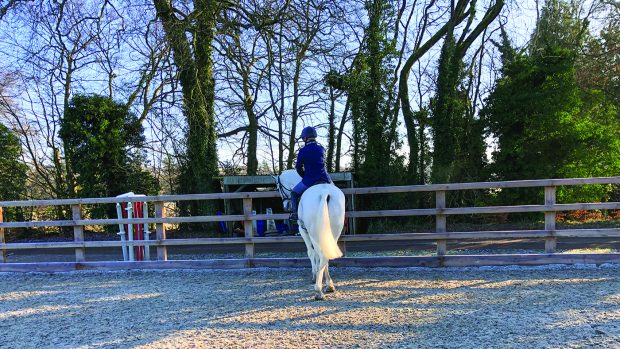Welcome to the fifth e-Lesson in the series. This week Keith Robertson explains how to master your give and retake during prelim 14 and gives us some top tips for training your horse to have a soft and accepting mouth. Enjoy your schooling and remember to let us know how you got on!
Session 1: mastering your give and retake
The give and retake is designed to show that your horse is in balance and is not relying on your hands.
You need to demonstrate a clear and obvious release of contact for three or four steps over the centre line. You should allow enough opportunity for the judge to see, but not so long that the horse loses balance.
Give and retake your reins smoothly so that the horse isn’t shocked or disturbed and therefore loses the consistency of the circle. Your horse should look comfortable when you retake the contact.
To try at home…
First practise giving and retaking your reins in a corner, as you don’t want a big, hot horse powering round corners or cutting them. If you do have an onwards horse, give him a forewarning, such as the odd half-halt.
Then work on keeping your horse between leg and hand during the give and retake. You want him to remain in self-carriage and not speed up — the temptation for him will be to surge forward but you must hold him with your seat.
Don’t give and retake unless you feel that you have your horse collected. If he’s not it will give him the opportunity to run away with you. If, when you give the reins, he puts his head up or runs off, try just giving with the inside rein quietly, keeping the outside rein to half-halt, and build it up from there.
Let others know if you found this session effective in our Facebook group.

Session 2: training your horse to have a soft and accepting mouth
At prelim level a lot of riders ask how they can train their horse to have a soft and accepting mouth, so these tips should help.
To start with, try riding in a loose-ring snaffle — the judge wants to see the horse accepting the bridle in a natural and soft way, so this is a good place to begin.
When riding, never pull back — your hands should stay there for the horse to work into so never try and balance him with the rein. Pulling is the beginning of the end as it blocks the horse and stops his hind leg from coming through and stepping underneath. The secret is never to allow the horse out of balance, so you’re never inclined to draw back.
Use your voice for downward transitions and don’t rely on your hands. Even if your horse breaks to canter from trot allow him to go forward for a moment and circle to bring him back to you.
Top tip: lungeing in loose side-reins helps the horse get used to working into that soft, consistent contact.
Session 3: practise the whole test
It’s now time to practise riding the test as a whole, but first watch this week’s test riding video with Isobel Wessels:
If you can not view the video player above please click here
Ensure that you are comfortable with the following given Keith and Isobel’s advice:
- Demonstrating a release of contact while maintaining the shape of the circle during the give and retake
- Medium walk (double score)
- Transitions to walk for one horse length




